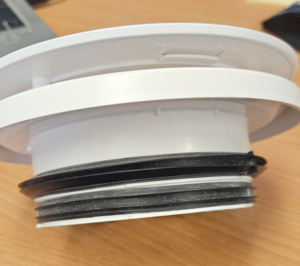In the fast-paced world of HVAC systems, there's one humble hero that often goes unnoticed – rubber seals. These small yet mighty components play a vital role in maintaining the efficiency and performance of heating, ventilation, and air conditioning systems.

When properly installed, rubber seals create an airtight barrier, preventing air leakage and ensuring optimal energy usage. This not only enhances the system's efficiency but also contributes to significant cost savings for both residential and commercial buildings.
But the power of rubber seals doesn't end there. They also help dampen noise levels, improve indoor air quality by preventing the entry of pollen and allergens, and provide protection against moisture, dust, and other unwanted elements.
Whether it's the compressors, condensers, or ductwork, rubber seals are the unsung heroes that keep HVAC systems running smoothly. With their ability to withstand extreme temperatures and resist environmental factors, rubber seals are a reliable and long-lasting solution.
So, the next time you adjust your thermostat, remember the unsung power of rubber seals that silently and efficiently seal the deal for your HVAC system.
Importance of rubber seals in HVAC systems
Rubber seals are the unsung heroes of HVAC systems, playing a crucial role in maintaining their efficiency and performance. These small yet vital components create an airtight barrier, preventing air leakage and ensuring optimal energy usage. By creating a tight seal, rubber seals help to minimize energy loss, leading to significant cost savings for both residential and commercial buildings.
Moreover, rubber seals contribute to enhanced indoor air quality by preventing the entry of pollen, allergens, and other unwanted elements. This is particularly important in HVAC systems, where the circulation of clean, filtered air is essential for maintaining a comfortable and healthy living or working environment. Rubber seals also help to dampen noise levels, making the HVAC system more discreet and less disruptive to the occupants.
Durability is another key advantage of rubber seals in HVAC systems. These components are designed to withstand extreme temperatures, harsh environmental conditions, and prolonged use without compromising their performance. This makes them a reliable and long-lasting solution for maintaining the overall efficiency and lifespan of HVAC systems. By ensuring a tight seal and protecting the system's internal components, rubber seals help to prevent costly breakdowns and extend the system's operational life.
Types of rubber seals used in HVAC systems
HVAC systems utilize a variety of rubber seals to ensure optimal performance and prevent air leakage. The most common types of rubber seals found in HVAC systems include:
Gaskets: Gaskets are flat, ring-shaped seals that are used to create a tight seal between two mating surfaces, such as between the compressor and the condenser unit. They are designed to compress and fill any gaps or irregularities, preventing air and fluid leaks.
O-rings: O-rings are circular, doughnut-shaped seals that are used to create a seal between two components that move in relation to each other, such as in the refrigerant lines or ductwork connections. They are known for their ability to withstand high pressure and temperature variations.
Grommets: Grommets are rubber or plastic rings that are used to protect wires, cables, or pipes as they pass through a hole or opening in a metal or plastic component. In HVAC systems, grommets are commonly used to seal the openings in the ductwork or the housing of the HVAC unit.
Weather stripping: Weather stripping is a long, continuous strip of rubber or other flexible material that is used to seal the gaps around doors and windows, preventing air infiltration and improving the overall energy efficiency of the HVAC system.
Each type of rubber seal is designed to address specific sealing requirements within the HVAC system, ensuring that the system operates at its optimal performance and efficiency levels.
Common issues with rubber seals in HVAC systems
Despite their importance, rubber seals in HVAC systems can occasionally encounter various issues that can compromise the system's performance and efficiency. Some of the most common issues include:
Wear and tear: Over time, the constant exposure to temperature fluctuations, UV radiation, and environmental factors can cause rubber seals to become brittle, cracked, or worn, leading to air leaks and reduced system performance.
Improper installation: Incorrect installation of rubber seals can result in gaps, misalignment, or uneven compression, which can lead to air and fluid leaks, as well as potential damage to other HVAC components.
Chemical degradation: Certain chemicals, such as oils, solvents, or cleaning agents, can react with the rubber material, causing it to swell, harden, or become brittle, compromising the seal's effectiveness.
Moisture and humidity: High levels of moisture or humidity can cause rubber seals to swell, soften, or degrade, leading to air leaks and the potential growth of mold or mildew within the HVAC system.
Vibration and movement: The constant vibration and movement of HVAC components can cause rubber seals to become dislodged, misaligned, or damaged over time, leading to air leaks and system inefficiencies.
Addressing these common issues with rubber seals in a timely and effective manner is crucial for maintaining the overall performance and energy efficiency of HVAC systems.
How to identify and diagnose rubber seal problems in HVAC systems
Identifying and diagnosing rubber seal problems in HVAC systems is an essential step in maintaining the system's efficiency and preventing costly breakdowns. Here are some key steps to help you identify and diagnose rubber seal issues:
Visual inspection: Carefully inspect the HVAC system's rubber seals for any visible signs of wear, cracking, or deterioration. Look for gaps, cracks, or signs of hardening or brittleness in the rubber material.
Air leakage testing: Perform an air leakage test to identify any areas where air is escaping the HVAC system. This can be done using a duct blaster or a similar device that measures the system's air tightness. Identify the areas with the highest air leakage, as these are likely the locations where the rubber seals are compromised.
Pressure and temperature monitoring: Monitor the pressure and temperature readings of the HVAC system, as these can provide valuable clues about the condition of the rubber seals. Significant fluctuations or deviations from the expected values may indicate issues with the seals, such as air or refrigerant leaks.
Ductwork and component inspection: Carefully inspect the ductwork, compressor, condenser, and other HVAC components for signs of damage or deterioration. Pay close attention to the areas where rubber seals are present, as these are the most likely points of failure.
Consultation with HVAC professionals: If you are unsure about the diagnosis or the extent of the rubber seal issues, it's always best to consult with experienced HVAC professionals. They can perform a comprehensive inspection and provide expert guidance on the appropriate course of action.
By following these steps, you can effectively identify and diagnose any rubber seal problems in your HVAC system, allowing you to take the necessary steps to address the issue and maintain the system's efficiency and performance.
Tips for maintaining and extending the lifespan of rubber seals in HVAC systems
Maintaining and extending the lifespan of rubber seals in HVAC systems is crucial for ensuring the system's optimal performance and energy efficiency. Here are some valuable tips to help you achieve this:
Regular inspection and maintenance: Establish a routine inspection and maintenance schedule for your HVAC system, paying particular attention to the condition of the rubber seals. This will allow you to identify and address any issues before they escalate into more serious problems.
Proper installation and replacement: Ensure that rubber seals are installed correctly, following the manufacturer's instructions. When replacing seals, use high-quality, compatible components to ensure a proper fit and seal. Improper installation can lead to air leaks and premature wear.
Lubrication and cleaning: Periodically clean the rubber seals with a mild, non-abrasive cleaner and apply a thin layer of silicone-based lubricant to help maintain their flexibility and prevent cracking or hardening.
Temperature and environmental control: Protect the HVAC system and its rubber seals from extreme temperature fluctuations, direct sunlight, and other environmental factors that can accelerate the degradation of the rubber material.
Proactive replacement: Replace rubber seals at the recommended intervals, or whenever they show signs of wear or damage. Don't wait until the seals fail, as this can lead to more extensive and costly repairs.
By following these tips, you can help extend the lifespan of the rubber seals in your HVAC system, ensuring its continued efficiency and reliability for years to come.
Steps to replace rubber seals in HVAC systems
Replacing worn or damaged rubber seals in HVAC systems is a crucial maintenance task that can help restore the system's performance and efficiency. Here are the steps to replace rubber seals in HVAC systems:
- Shut off power and disconnect the system: Before beginning any work, ensure that the HVAC system is turned off and disconnected from the power source to prevent any accidents or injuries.
- Identify and locate the damaged seals: Carefully inspect the HVAC system to identify the specific rubber seals that need to be replaced. This may involve accessing various components, such as the compressor, condenser, or ductwork.
- Gather the necessary replacement parts: Obtain the correct replacement seals, gaskets, or O-rings from a reputable HVAC parts supplier. Ensure that the new components are compatible with your specific HVAC system model and specifications.
- Properly remove the old seals: Carefully remove the old rubber seals, taking note of their orientation and position to ensure the new seals are installed correctly. Be gentle to avoid damaging the surrounding components.
- Clean the sealing surfaces: Thoroughly clean the surfaces where the new rubber seals will be installed, removing any dirt, debris, or residue that could interfere with the new seal's performance.
- Apply lubricant and install the new seals: Apply a thin layer of silicone-based lubricant to the new rubber seals to facilitate installation and ensure a proper seal. Carefully position and install the new seals, ensuring they are properly aligned and seated.
- Reassemble the HVAC system: Carefully reassemble the HVAC system, ensuring that all components are properly reconnected and that the new rubber seals are securely in place.
- Test and inspect the system: Turn the HVAC system back on and perform a thorough inspection to ensure that the new rubber seals are functioning correctly and that there are no air or fluid leaks.
By following these steps, you can effectively replace the rubber seals in your HVAC system, restoring its efficiency and preventing future issues caused by worn or damaged seals.
The role of rubber seal manufacturers in the HVAC industry
Rubber seal manufacturers play a crucial role in supporting the HVAC industry and ensuring the optimal performance of HVAC systems. These manufacturers are responsible for developing and producing high-quality rubber seals that meet the specific requirements of HVAC applications.
One of the primary responsibilities of rubber seal manufacturers is to stay up-to-date with the latest HVAC industry trends and technological advancements. By understanding the evolving needs and challenges faced by HVAC system designers and installers, these manufacturers can develop innovative rubber seal solutions that address the changing requirements of the industry.
Rubber seal manufacturers also work closely with HVAC equipment and component manufacturers to ensure that their products are compatible and integrated seamlessly into the overall HVAC system. This collaboration ensures that the rubber seals not only provide an effective seal but also contribute to the overall efficiency and reliability of the HVAC system.
In addition to product development, rubber seal manufacturers play a critical role in ensuring the quality and durability of their products. They employ rigorous testing and quality control measures to ensure that their rubber seals can withstand the harsh environmental conditions and temperature extremes that are common in HVAC applications.
Furthermore, rubber seal manufacturers often provide technical support and training to HVAC contractors and technicians, helping them to properly install and maintain the rubber seals in their HVAC systems. This support helps to extend the lifespan of the rubber seals and prevent premature failures, ultimately contributing to the overall performance and efficiency of the HVAC system.
By collaborating with HVAC manufacturers, developing innovative solutions, and providing technical support, rubber seal manufacturers play a vital role in the HVAC industry, ensuring that HVAC systems operate at their optimal levels and deliver reliable, energy-efficient performance.
Innovations and advancements in rubber seals for HVAC systems
The HVAC industry is constantly evolving, and rubber seal manufacturers are at the forefront of developing innovative solutions to meet the changing needs of the market. Here are some of the latest advancements and innovations in rubber seals for HVAC systems:
- Improved thermal and chemical resistance: Rubber seal manufacturers are developing new formulations and materials that offer enhanced thermal and chemical resistance, allowing the seals to withstand the harsh operating conditions of HVAC systems more effectively. This helps to extend the lifespan of the rubber seals and prevent premature failure.
- Enhanced flexibility and durability: Advances in rubber compound technology have resulted in the creation of rubber seals that are more flexible and durable, allowing them to better accommodate the constant movement and vibration of HVAC components. This helps to maintain a tight seal and prevent air leaks over the long term.
- Increased energy efficiency: Some rubber seal manufacturers are focusing on developing solutions that contribute to the overall energy efficiency of HVAC systems. This includes designing seals with improved air-tight properties, which can help reduce energy consumption and lower operating costs for building owners and operators.
- Environmentally-friendly materials: Driven by the growing emphasis on sustainability, rubber seal manufacturers are exploring the use of eco-friendly materials, such as bio-based or recycled rubber, to reduce the environmental impact of their products. This aligns with the HVAC industry's efforts to adopt more sustainable practices.
- Integrated sensor technology: Advancements in sensor technology have enabled the integration of smart features into rubber seals. These sensors can monitor the condition of the seals, detect potential issues, and provide real-time data to HVAC system operators, allowing for proactive maintenance and improved system performance.
- Customized solutions: Rubber seal manufacturers are increasingly offering customized solutions to meet the specific needs of HVAC system designers and installers. This includes developing seals with unique shapes, sizes, and material properties to address the unique challenges of different HVAC applications.
By staying at the forefront of these innovations and advancements, rubber seal manufacturers are helping to drive the HVAC industry forward, contributing to the development of more efficient, reliable, and sustainable HVAC systems.
Conclusion: The impact of rubber seals on the performance and efficiency of HVAC systems
Rubber seals are the unsung heroes of HVAC systems, playing a vital role in maintaining the efficiency, performance, and reliability of these critical infrastructure components. From creating an airtight barrier to preventing air leaks and enhancing indoor air quality, rubber seals are essential for ensuring the optimal operation of HVAC systems.
The various types of rubber seals used in HVAC systems, including gaskets, O-rings, grommets, and weather stripping, are designed to address specific sealing requirements and environmental conditions. However, these seals can occasionally encounter issues such as wear and tear, improper installation, chemical degradation, and the effects of moisture and vibration.
By implementing a proactive approach to rubber seal maintenance and replacement, HVAC system owners and operators can extend the lifespan of their equipment, reduce energy costs, and ensure a comfortable and healthy indoor environment. This includes regular inspections, proper installation techniques, and the use of high-quality replacement parts.
Rubber seal manufacturers play a crucial role in supporting the HVAC industry, developing innovative solutions that address the evolving needs of the market. From improved thermal and chemical resistance to enhanced flexibility and energy efficiency, these advancements in rubber seal technology are helping to drive the HVAC industry forward, contributing to the development of more sustainable and reliable systems.
As the HVAC industry continues to evolve, the importance of rubber seals will only grow. By understanding the critical role these humble components play in maintaining the performance and efficiency of HVAC systems, building owners, operators, and HVAC professionals can ensure that their systems continue to operate at their best, delivering reliable and energy-efficient comfort for years to come.







